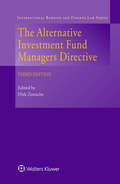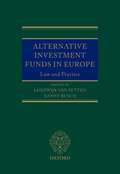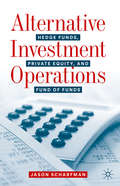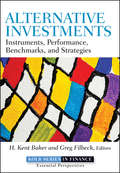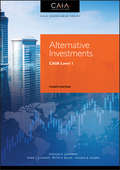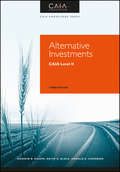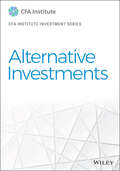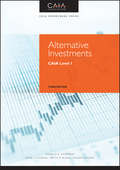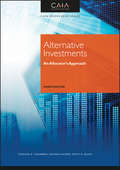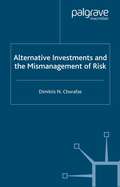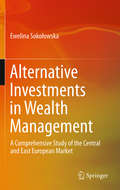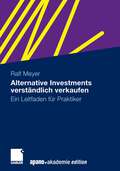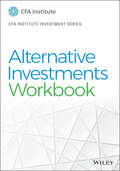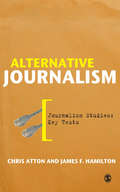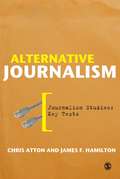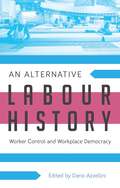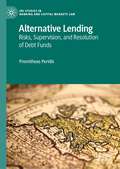- Table View
- List View
The Alternative Investment Fund Managers Directive
by Dirk ZetzscheIn the ten years since its coming into force, the Alternative Investment Fund Managers Directive (AIFMD), with almost EUR 7 trillion assets under management in its remit, has become an important piece of European regulation complementing the Undertakings for Collective Investment in Transferable Securities (UCITS) and the Markets in Financial Instruments (MiFI) frameworks. This third edition of the most comprehensive and in-depth analysis of the AIFMD and its related European investment fund legislation (including the European Venture Capital Fund Regulation, the European Social Entrepreneurship Fund Regulation, the European Long-Term Investment Fund Regulation and the European Money Market Fund Regulation among others) brings together fund industry experts, fund supervisors, consultants, lawyers and academics to discuss the content and system of the directive from every angle, including its relation not only to the UCITS and MiFI frameworks but also to pension funds, the Sustainable Finance Disclosure Regulation, the Securitization Regulation and the Cross Border Funds Distribution Directive and Regulation, as well as related pieces of tax regulation at the European level. Further, the third edition emphasizes the function of such factors in the financial services value chain as the following: the AIFMD’s approach to robo-advisors; digital asset funds; infrastructure investments in the context of real estate and sustainable investments; risk management; transparency; and impact on alternative investment strategies. Five country reports, focusing on the European Union’s five most important financial centres for alternative investment funds, deal with the potential interactions among the AIFMD and the relevant laws and regulations of France, Germany, Luxembourg, Ireland and The Netherlands. This thoroughly updated edition elaborates on potential difficulties encountered when applying the directive and provides potential solutions to the problems it raises. The book is sure to be warmly welcomed by fund lawyers and consultants, investors and their counsels, fund managers, depositaries, asset managers and administrators, as well as regulators and academics in the field.
Alternative Investment Funds in Europe (Oxford EU Financial Regulation)
The book provides a full and practical review of the impact of the highly controversial European Directive on Alternative Investment Fund Managers, which was adopted after much debate in October 2010 (AIFMD). The AIFMD is intended to be a regulatory response to systematic risks that came to light in the financial crisis and will have a broad and material impact on the manner in which investment managers may operate and offer non-retail funds (including hedge funds, private equity funds, real estate funds and infrastructure funds), which were previously largely unregulated. The AIFMD not only regulates fund managers based in the EU, but also seeks to regulate non-EU managers who seek to offer non-EU funds to EU investors. Accordingly, the AIFMD will impact all fund offerings to professional investors based in the EU, potentially severely limiting the range of investments available to EU pension funds, insurance companies and other institutional investors. The book begins with a detailed review of the AIFMD itself, including the 'Level 2' rules. The bulk of the book consists of chapters that analyse and explain the national implementation legislation of the EU Member States. Through this structure, the work provides the reader with fast-track access to the regulation at European and national level of non-retail EU and non-EU funds and fund managers, which are caught by the AIFMD.
Alternative Investment Operations: Hedge Funds, Private Equity, and Fund of Funds
by Jason ScharfmanAlternative investments such as hedge funds, private equity, and fund of funds continue to be of strong interest among the investment community. As these investment strategies have become increasingly complex, fund managers have continued to devote more time and resources towards developing best practice operations to support the actual trade processing, fund accounting, and back-office mechanics that allow these strategies to function. Representative of this operational growth, estimates have indicated that fund managers have seen increased operating budgets of 30% or more in recent years.In today’s highly regulated environment, alternative investment managers have also increasingly had to integrate rigorous compliance and cybersecurity oversight into fund operations. Additionally, with recent advances in artificial intelligence and big data analysis, fund managers are devoting larger portions of their information technology budgets towards realizing technology-based operational efficiencies. Alternative investment fund service providers have also substantially increased their scope and breadth of their operations-related services. Furthermore, investors are increasingly performing deep-dive due diligence on fund manager operations at both fund level and management company levels.This book provides current and practical guidance on the foundations of how alternative investment managers build and manage their operations. While other publications have focused on generalized overviews of historical trading procedures across multiple asset classes, and the technical intricacies of specific legacy operational procedures, Alternative Investment Operations will be the first book to focus on explaining up-to-date information on the specific real-world operational practices actually employed by alternative investment managers. This book will focus on how to actually establish and manage fund operations. Alternative Investment Operations will be an invaluable up-to-date resource for fund managers and their operations personnel as well as investors and service providers on the implementation and management of best practice operations.
Alternative Investments: Instruments, Performance, Benchmarks, and Strategies (Robert W. Kolb Series #609)
by H. Kent Baker Greg FilbeckA comprehensive guide to alternative investments that reveals today's latest research and strategies Historically low interest rates and bear markets in world stock markets have generated intense interest in alternative investments. With returns in traditional investment vehicles relatively low, many professional investors view alternative investments as a means of meeting their return objectives. Alternative Investments: Instruments, Performance, Benchmarks, and Strategies, can put you in a better position to achieve this difficult goal. Part of the Robert W. Kolb Series in Finance, Alternative Investments provides an in-depth discussion of the historic performance, benchmarks, and strategies of every major alternative investment market. With contributions from professionals and academics around the world, it offers valuable insights on the latest trends, research, and thinking in each major area. Empirical evidence about each type of alternative investment is featured, with research presented in a straightforward manner. Examines a variety of major alternative asset classes, from real estate, private equity, and commodities to managed futures, hedge funds, and distressed securities Provides detailed insights on the latest research and strategies, and offers a thorough explanation of historical performance, benchmarks, and other critical information Blends knowledge from the conceptual world of scholars with the pragmatic view of practitioners in this field Alternative investments provide a means of diversification, risk control, and return enhancement and, as such, are attractive to many professional investors. If you're looking for an effective way to hone your skills in this dynamic area of finance, look no further than this book.
Alternative Investments: Instruments, Performance, Benchmarks, and Strategies (Robert W. Kolb Series #608)
by H. Kent Baker Greg FilbeckA comprehensive guide to alternative investments that reveals today's latest research and strategies Historically low interest rates and bear markets in world stock markets have generated intense interest in alternative investments. With returns in traditional investment vehicles relatively low, many professional investors view alternative investments as a means of meeting their return objectives. Alternative Investments: Instruments, Performance, Benchmarks, and Strategies, can put you in a better position to achieve this difficult goal. Part of the Robert W. Kolb Series in Finance, Alternative Investments provides an in-depth discussion of the historic performance, benchmarks, and strategies of every major alternative investment market. With contributions from professionals and academics around the world, it offers valuable insights on the latest trends, research, and thinking in each major area. Empirical evidence about each type of alternative investment is featured, with research presented in a straightforward manner. Examines a variety of major alternative asset classes, from real estate, private equity, and commodities to managed futures, hedge funds, and distressed securities Provides detailed insights on the latest research and strategies, and offers a thorough explanation of historical performance, benchmarks, and other critical information Blends knowledge from the conceptual world of scholars with the pragmatic view of practitioners in this field Alternative investments provide a means of diversification, risk control, and return enhancement and, as such, are attractive to many professional investors. If you're looking for an effective way to hone your skills in this dynamic area of finance, look no further than this book.
Alternative Investments: CAIA Level I (Wiley Finance)
by Keith Black CAIA Association Hossein Kazemi Donald Chambers Mark AnsonAlternative Investments: CAIA Level I, 4th Edition is the curriculum book for the Chartered Alternative Investment Analyst (CAIA) Level I professional examination. Covering the fundamentals of the alternative investment space, this book helps you build a foundation in alternative investment markets. You'll look closely at the different types of hedge fund strategies and the range of statistics used to define investment performance as you gain a deep familiarity with alternative investment terms and develop the computational ability to solve investment problems. From strategy characteristics to portfolio management strategies, this book contains the core material you will need to succeed on the CAIA Level I exam. This updated fourth edition tracks to the latest version of the exam and is accompanied by the following ancillaries: a workbook, study guide, learning objectives, and an ethics handbook.
Alternative Investments: CAIA Level I (Wiley Finance)
by CAIA Association Mark J. Anson Keith H. Black Donald R. Chambers Hossein B. KazemiAlternative Investments: CAIA Level I, 4th Edition is the curriculum book for the Chartered Alternative Investment Analyst (CAIA) Level I professional examination. Covering the fundamentals of the alternative investment space, this book helps you build a foundation in alternative investment markets. You'll look closely at the different types of hedge fund strategies and the range of statistics used to define investment performance as you gain a deep familiarity with alternative investment terms and develop the computational ability to solve investment problems. From strategy characteristics to portfolio management strategies, this book contains the core material you will need to succeed on the CAIA Level I exam. This updated fourth edition tracks to the latest version of the exam and is accompanied by the following ancillaries: a workbook, study guide, learning objectives, and an ethics handbook.
Alternative Investments: CAIA Level II
by CAIA Association Hossein Kazemi Keith H. Black Donald R. ChambersIn-depth Level II exam preparation direct from the CAIA Association CAIA Level II is the official study guide for the Chartered Alternative Investment Analyst professional examination, and an authoritative guide to working in the alternative investment sphere. Written by the makers of the exam, this book provides in-depth guidance through the entire exam agenda; the Level II strategies are the same as Level I, but this time you'll review them through the lens of risk management and portfolio optimisation. Topics include asset allocation and portfolio oversight, style analysis, risk management, alternative asset securitisation, secondary market creation, performance and style attribution and indexing and benchmarking, with clear organisation and a logical progression that allows you to customise your preparation focus. This new third edition has been updated to align with the latest exam, and to reflect the current practices in the field. The CAIA designation was developed to provide a standardized knowledge base in the midst of explosive capital inflow into alternative investments. This book provides a single-source repository of that essential information, tailored to those preparing for the Level II exam. Measure, monitor and manage funds from a risk management perspective Delve into advanced portfolio structures and optimisation strategies Master the nuances of private equity, real assets, commodities and hedge funds Gain expert insight into preparing thoroughly for the CAIA Level II exam The CAIA Charter programme is rigorous and comprehensive, and the designation is globally recognised as the highest standard in alternative investment education. Candidates seeking thorough preparation and detailed explanations of all aspects of alternative investment need look no further than CAIA Level II.
Alternative Investments: CAIA Level II
by CAIA Association Hossein Kazemi Keith H. Black Donald R. ChambersIn-depth Level II exam preparation direct from the CAIA Association CAIA Level II is the official study guide for the Chartered Alternative Investment Analyst professional examination, and an authoritative guide to working in the alternative investment sphere. Written by the makers of the exam, this book provides in-depth guidance through the entire exam agenda; the Level II strategies are the same as Level I, but this time you'll review them through the lens of risk management and portfolio optimisation. Topics include asset allocation and portfolio oversight, style analysis, risk management, alternative asset securitisation, secondary market creation, performance and style attribution and indexing and benchmarking, with clear organisation and a logical progression that allows you to customise your preparation focus. This new third edition has been updated to align with the latest exam, and to reflect the current practices in the field. The CAIA designation was developed to provide a standardized knowledge base in the midst of explosive capital inflow into alternative investments. This book provides a single-source repository of that essential information, tailored to those preparing for the Level II exam. Measure, monitor and manage funds from a risk management perspective Delve into advanced portfolio structures and optimisation strategies Master the nuances of private equity, real assets, commodities and hedge funds Gain expert insight into preparing thoroughly for the CAIA Level II exam The CAIA Charter programme is rigorous and comprehensive, and the designation is globally recognised as the highest standard in alternative investment education. Candidates seeking thorough preparation and detailed explanations of all aspects of alternative investment need look no further than CAIA Level II.
Alternative Investments (CFA Institute Investment Series)
by CFA InstituteThe complete guide to alternative investments, from experts working with CFA Institute Alternative Investments is the definitive guide to understanding non-traditional asset classes. Alternatives are a disparate group of investments that are distinguished from long-only, publicly traded investments in stocks, bonds, and cash (often referred to as traditional investments). Alternative investments include real estate, commodities, infrastructure, and other non-traditional investments such as private equity or debt and hedge funds. They are attractive to investors because of the potential for portfolio diversification resulting in a higher risk-adjusted return for the portfolio. Alternative Investments and its accompanying workbook (sold separately) lead students and investment professionals through the many characteristics of non-traditional assets, including: Narrow specialization of the investment managers Relatively low correlation of returns with those of traditional investments Less regulation and less transparency than traditional investments Limited historical risk and return data Unique legal and tax considerations Higher fees, often including performance or incentive fees Concentrated portfolios Restrictions on redemptions (i.e. “lockups” and “gates”) CFA Institute is the world's premier association for investment professionals, and the governing body for the CFA® Program, CIPM® Program, CFA Institute ESG Investing Certificate, and Investment Foundations® Program. Those seeking a deeper understanding of the markets, mechanisms, and use of alternatives will value the level of expertise CFA Institute brings to the discussion, providing a clear, comprehensive resource for students and professionals alike. Whether used alone or in conjunction with the companion workbook, Alternative Investments offers a complete course in alternative investments and their role in investment management.
Alternative Investments (CFA Institute Investment Series)
by CFA InstituteThe complete guide to alternative investments, from experts working with CFA Institute Alternative Investments is the definitive guide to understanding non-traditional asset classes. Alternatives are a disparate group of investments that are distinguished from long-only, publicly traded investments in stocks, bonds, and cash (often referred to as traditional investments). Alternative investments include real estate, commodities, infrastructure, and other non-traditional investments such as private equity or debt and hedge funds. They are attractive to investors because of the potential for portfolio diversification resulting in a higher risk-adjusted return for the portfolio. Alternative Investments and its accompanying workbook (sold separately) lead students and investment professionals through the many characteristics of non-traditional assets, including: Narrow specialization of the investment managers Relatively low correlation of returns with those of traditional investments Less regulation and less transparency than traditional investments Limited historical risk and return data Unique legal and tax considerations Higher fees, often including performance or incentive fees Concentrated portfolios Restrictions on redemptions (i.e. “lockups” and “gates”) CFA Institute is the world's premier association for investment professionals, and the governing body for the CFA® Program, CIPM® Program, CFA Institute ESG Investing Certificate, and Investment Foundations® Program. Those seeking a deeper understanding of the markets, mechanisms, and use of alternatives will value the level of expertise CFA Institute brings to the discussion, providing a clear, comprehensive resource for students and professionals alike. Whether used alone or in conjunction with the companion workbook, Alternative Investments offers a complete course in alternative investments and their role in investment management.
Alternative Investments: CAIA Level I (Wiley Finance #194)
by Donald R. Chambers Mark J. Anson Keith H. Black Hossein Kazemi CAIA AssociationThe official CAIA Level 1 curriculum bookAlternative Investments: CAIA Level I, 3rd Edition is the curriculum book for the Chartered Alternative Investment Analyst (CAIA) Level I professional examination. Covering the fundamentals of the alternative investment space, this book helps you build a foundation in alternative investment markets. You'll look closely at the different types of hedge fund strategies and the range of statistics used to define investment performance as you gain a deep familiarity with alternative investment terms and develop the computational ability to solve investment problems. From strategy characteristics to portfolio management strategies, this book contains the core material you will need to succeed on the CAIA Level I exam. This updated third edition tracks to the latest version of the exam, and is accompanied by the following ancillaries: a workbook, study guide, learning objectives, and an ethics handbook. Most investment analyst education programs focus primarily on the traditional asset classes, pushing alternative investments to the sidelines. The CAIA designation was developed in response to the tremendous growth of alternative investing, and is the industry's premier educational standard. This book is your official study companion, bringing you fully up to speed on everything you need to know (with the exception of the ethics material covered in a separate handbook). Understand the complexities of each alternative asset class Learn the quantitative techniques professionals use every day Dig into the unique aspects of alternative investments Master the core material covered by the CAIA Level I exam More than 300 financial institutions and hedge funds have committed key executives to the CAIA exam, and this rapidly growing trend speaks to the designation's rising status as a must-have credential for anyone in the alternative investment sphere. Increase your chances of success by getting your information straight from the source in CAIA Level I.
Alternative Investments: CAIA Level I (Wiley Finance)
by Donald R. Chambers Mark J. Anson Keith H. Black Hossein Kazemi CAIA AssociationThe official CAIA Level 1 curriculum bookAlternative Investments: CAIA Level I, 3rd Edition is the curriculum book for the Chartered Alternative Investment Analyst (CAIA) Level I professional examination. Covering the fundamentals of the alternative investment space, this book helps you build a foundation in alternative investment markets. You'll look closely at the different types of hedge fund strategies and the range of statistics used to define investment performance as you gain a deep familiarity with alternative investment terms and develop the computational ability to solve investment problems. From strategy characteristics to portfolio management strategies, this book contains the core material you will need to succeed on the CAIA Level I exam. This updated third edition tracks to the latest version of the exam, and is accompanied by the following ancillaries: a workbook, study guide, learning objectives, and an ethics handbook. Most investment analyst education programs focus primarily on the traditional asset classes, pushing alternative investments to the sidelines. The CAIA designation was developed in response to the tremendous growth of alternative investing, and is the industry's premier educational standard. This book is your official study companion, bringing you fully up to speed on everything you need to know (with the exception of the ethics material covered in a separate handbook). Understand the complexities of each alternative asset class Learn the quantitative techniques professionals use every day Dig into the unique aspects of alternative investments Master the core material covered by the CAIA Level I exam More than 300 financial institutions and hedge funds have committed key executives to the CAIA exam, and this rapidly growing trend speaks to the designation's rising status as a must-have credential for anyone in the alternative investment sphere. Increase your chances of success by getting your information straight from the source in CAIA Level I.
Alternative Investments: An Allocator's Approach (Wiley Finance Ser.)
by Donald R. Chambers Hossein B. Kazemi Keith H. Black CAIA AssociationWhether you are a seasoned professional looking to explore new areas within the alternative investment arena or a new industry participant seeking to establish a solid understanding of alternative investments, Alternative Investments: An Allocator's Approach, Fourth Edition (CAIA Level II curriculum official text) is the best way to achieve these goals. In recent years, capital formation has shifted dramatically away from public markets as issuers pursue better financial and value alignment with ownership, less onerous and expensive regulatory requirements, market and information dislocation, and liberation from the short-term challenges that undergird the public capital markets. The careful and informed use of alternative investments in a diversified portfolio can reduce risk, lower volatility, and improve returns over the long-term, enhancing investors' ability to meet their investment outcomes. Alternative Investments: An Allocator's Approach (CAIA Level II curriculum official text) is a key resource that can be used to improve the sophistication of asset owners and those who work with them. This text comprises the curriculum, when combined with supplemental materials available at caia.org, for the CAIA Level II exam. "Over the course of my long career one tenet has held true, 'Continuing Education'. Since CalSTRS is a teachers' pension plan, it is no surprise that continuing education is a core attribute of our Investment Office culture. Overseeing one of the largest institutional pools of capital in the world requires a cohesive knowledge and understanding of both public and private market investments and strategies. We must understand how these opportunities might contribute to delivering on investment outcomes for our beneficiaries. Alternative Investments: An Allocator's Approach is the definitive core instruction manual for an institutional investor, and it puts you in the captain's chair of the asset owner."—Christopher J. Ailman, Chief Investment Officer, California State Teachers’ Retirement System "Given their diversified cash flow streams and returns, private markets continue to be a growing fixture of patient, long-term portfolios. As such, the need to have proficiency across these sophisticated strategies, asset classes, and instruments is critical for today's capital allocator. As a proud CAIA charterholder, I have seen the practical benefits in building a strong private markets foundation, allowing me to better assist my clients."—Jayne Bok, CAIA, CFA, Head of Investments, Asia, Willis Tower Watson
Alternative Investments: An Allocator's Approach (Wiley Finance Ser.)
by Donald R. Chambers Hossein B. Kazemi Keith H. Black CAIA AssociationWhether you are a seasoned professional looking to explore new areas within the alternative investment arena or a new industry participant seeking to establish a solid understanding of alternative investments, Alternative Investments: An Allocator's Approach, Fourth Edition (CAIA Level II curriculum official text) is the best way to achieve these goals. In recent years, capital formation has shifted dramatically away from public markets as issuers pursue better financial and value alignment with ownership, less onerous and expensive regulatory requirements, market and information dislocation, and liberation from the short-term challenges that undergird the public capital markets. The careful and informed use of alternative investments in a diversified portfolio can reduce risk, lower volatility, and improve returns over the long-term, enhancing investors' ability to meet their investment outcomes. Alternative Investments: An Allocator's Approach (CAIA Level II curriculum official text) is a key resource that can be used to improve the sophistication of asset owners and those who work with them. This text comprises the curriculum, when combined with supplemental materials available at caia.org, for the CAIA Level II exam. "Over the course of my long career one tenet has held true, 'Continuing Education'. Since CalSTRS is a teachers' pension plan, it is no surprise that continuing education is a core attribute of our Investment Office culture. Overseeing one of the largest institutional pools of capital in the world requires a cohesive knowledge and understanding of both public and private market investments and strategies. We must understand how these opportunities might contribute to delivering on investment outcomes for our beneficiaries. Alternative Investments: An Allocator's Approach is the definitive core instruction manual for an institutional investor, and it puts you in the captain's chair of the asset owner."—Christopher J. Ailman, Chief Investment Officer, California State Teachers’ Retirement System "Given their diversified cash flow streams and returns, private markets continue to be a growing fixture of patient, long-term portfolios. As such, the need to have proficiency across these sophisticated strategies, asset classes, and instruments is critical for today's capital allocator. As a proud CAIA charterholder, I have seen the practical benefits in building a strong private markets foundation, allowing me to better assist my clients."—Jayne Bok, CAIA, CFA, Head of Investments, Asia, Willis Tower Watson
Alternative Investments and the Mismanagement of Risk
by D. Chorafas'Investors beware' is good advice in any situation, especially when dealing with the control of risk and alternative investments. In this book Chorafas has uncovered the hidden risks behind alternative investments through extensive research in the US, UK, Germany France, Italy Scandinavia and Switzerland. He also provides solutions to the problems identified. This book is particularly important in light of recent scandals such as Enron and WorldCom.
Alternative Investments in Wealth Management: A Comprehensive Study of the Central and East European Market
by Ewelina SokołowskaThis monograph provides a comprehensive source of analysis and research on alternative investments in the wealth management process, with a special focus on Poland and Eastern Europe. It presents the characteristics that distinguish alternative investments from traditional investments and illustrates the benefits and risks involved in the former. The experience gained in developed countries is extremely valuable for the analysis of both the Polish and Eastern European financial markets. In the theoretical part of the book, key aspects of alternative investments are collected, systematized and developed; subsequently, in the empirical part the results of selected studies on the alternative investment sector around the world are examined. Lastly, the book’s findings are applied to the context of alternative financial investments in Poland, investigating the preferences for alternative investments in the country, which is the largest market in Central and Eastern Europe. Not only of theoretical interest, these insights have a high application value, making the book an essential resource for scholars, practitioners and policymakers alike.
Alternative Investments verständlich verkaufen: Ein Leitfaden für Praktiker
by Ralf MeyerBasis für eine kundenorientierte Beratung sind eine hervorragende Fachkompetenz und ein guter Einblick in wirtschaftliche Zusammenhänge. Genauso entscheidend ist dann jedoch, dass diese Informationen anlegergerecht vermittelt werden. Der Kunde soll in die Lage versetzt werden, die Tragweite seiner Entscheidungen einschätzen zu können. Somit sind Transparenz, Nachvollziehbarkeit und Verständlichkeit die Schlüsselfaktoren. Dieses Buch liefert Ihnen viele Ideen und Anregungen für Ihre Beratungsgespräche. Sie erhalten praxiserprobte Ratschläge, wie es Ihnen hervorragend gelingen kann, in einem schwierigen Umfeld Geschäftsmöglichkeiten zu entdecken und zu nutzen.
Alternative Investments Workbook (CFA Institute Investment Series)
by CFA InstituteHands-on practice with alternative investments based on real-world scenarios Alternative Investments Workbook provides the key component of effective learning—practice. Designed for both students and investment professionals, this companion workbook conveniently aligns with the Alternative Investments text chapter-by-chapter, offers brief chapter summaries to refresh your memory on key points before you begin working, and explicitly lays out the learning objectives so you understand the “why” of each problem. This workbook helps you: Synthesize essential material from the Alternative Investments text using real-world applications Understand the key characteristics of non-traditional investments Work toward specific chapter objectives to internalize important information CFA Institute is the world's premier association for investment professionals, and the governing body for the CFA® Program, CIPM® Program, CFA Institute ESG Investing Certificate, and Investment Foundations® Program. Those seeking a deeper understanding of the markets, mechanisms, and use of alternatives will value the level of expertise CFA Institute brings to the discussion as well as the extra practice delivered in Alternative Investments Workbook based on real scenarios investors face every day.
Alternative Investments Workbook (CFA Institute Investment Series)
by CFA InstituteHands-on practice with alternative investments based on real-world scenarios Alternative Investments Workbook provides the key component of effective learning—practice. Designed for both students and investment professionals, this companion workbook conveniently aligns with the Alternative Investments text chapter-by-chapter, offers brief chapter summaries to refresh your memory on key points before you begin working, and explicitly lays out the learning objectives so you understand the “why” of each problem. This workbook helps you: Synthesize essential material from the Alternative Investments text using real-world applications Understand the key characteristics of non-traditional investments Work toward specific chapter objectives to internalize important information CFA Institute is the world's premier association for investment professionals, and the governing body for the CFA® Program, CIPM® Program, CFA Institute ESG Investing Certificate, and Investment Foundations® Program. Those seeking a deeper understanding of the markets, mechanisms, and use of alternatives will value the level of expertise CFA Institute brings to the discussion as well as the extra practice delivered in Alternative Investments Workbook based on real scenarios investors face every day.
Alternative Journalism
by Dr James F. Hamilton Professor Chris Atton"A provocative, inspiring and challenging intervention in both journalism and media studies.... Alternative Journalism is that rare book that services students as much as scholars. It widens the trajectory of media studies and creates different modes of reading, writing and thinking... It offers an alternative history beyond the tales of great men, great newspapers, great editors and great technologies. It adds value and content to overused and ambiguous words such as "community" and "citizenship" and captures the spark of new information environments." - THE, (Times Higher Education) Alternative Journalism investigates and analyses the diverse forms and genres of journalism that have arisen as challenges to mainstream news coverage. From the radical content of emancipatory media to the dizzying range of citizen journalist blogs and fanzine subcultures, this book charts the historical and cultural practices of this diverse and globalized phenomenon. This exploration goes to the heart of journalism itself, prompting a critical inquiry into the epistemology of news, the professional norms of objectivity, the elite basis of journalism and the hierarchical commerce of news production. In investigating the challenges to media power presented by alternative journalism, Atton addresses not just the issues of politics and empowerment but also the journalism of popular culture and the everyday. The result is essential reading for students of journalism - both mainstream and alternative.
Alternative Journalism (PDF)
by Dr James F. Hamilton Professor Chris Atton"A provocative, inspiring and challenging intervention in both journalism and media studies.... Alternative Journalism is that rare book that services students as much as scholars. It widens the trajectory of media studies and creates different modes of reading, writing and thinking... It offers an alternative history beyond the tales of great men, great newspapers, great editors and great technologies. It adds value and content to overused and ambiguous words such as "community" and "citizenship" and captures the spark of new information environments." - THE, (Times Higher Education) Alternative Journalism investigates and analyses the diverse forms and genres of journalism that have arisen as challenges to mainstream news coverage. From the radical content of emancipatory media to the dizzying range of citizen journalist blogs and fanzine subcultures, this book charts the historical and cultural practices of this diverse and globalized phenomenon. This exploration goes to the heart of journalism itself, prompting a critical inquiry into the epistemology of news, the professional norms of objectivity, the elite basis of journalism and the hierarchical commerce of news production. In investigating the challenges to media power presented by alternative journalism, Atton addresses not just the issues of politics and empowerment but also the journalism of popular culture and the everyday. The result is essential reading for students of journalism - both mainstream and alternative.
An Alternative Labour History: Worker Control and Workplace Democracy
by Dario AzzelliniThe global financial crisis has led to a new shop-floor militancy. Radical forms of protest and new workers' takeovers have sprung up all over the globe. In the US, Republic Windows and Doors started production under worker control in January 2013. Later that year workers in Greece took over and managed a hotel, a hospital, a newspaper, a TV channel and a factory.The dominant revolutionary left has viewed workers' control as part of a system necessary during a transition to socialism. Yet most socialist and communist parties have neglected to promote workers' control as it challenges the centrality of parties and it is in this spirit that trade unions, operating through the institutional frameworks of government, have held a monopoly over labor history.Tracing Marx's writings on the Paris Commune through council communism, anarcho-syndicalism, Italian operaismo, and other "heretical" left currents, An Alternative Labour History uncovers the practices and intentions of historical and contemporary autonomous workers' movements that until now have been largely obscured. It shows that by bringing permanence and predictability to their workplaces, workers can stabilize their communities through expressions of participatory democracy. And, as history has repeatedly shown, workers have always had the capacity to run their enterprises on their own.
An Alternative Labour History: Worker Control and Workplace Democracy
by Dario AzzelliniThe global financial crisis has led to a new shop-floor militancy. Radical forms of protest and new workers' takeovers have sprung up all over the globe. In the US, Republic Windows and Doors started production under worker control in January 2013. Later that year workers in Greece took over and managed a hotel, a hospital, a newspaper, a TV channel and a factory.The dominant revolutionary left has viewed workers' control as part of a system necessary during a transition to socialism. Yet most socialist and communist parties have neglected to promote workers' control as it challenges the centrality of parties and it is in this spirit that trade unions, operating through the institutional frameworks of government, have held a monopoly over labor history.Tracing Marx's writings on the Paris Commune through council communism, anarcho-syndicalism, Italian operaismo, and other "heretical" left currents, An Alternative Labour History uncovers the practices and intentions of historical and contemporary autonomous workers' movements that until now have been largely obscured. It shows that by bringing permanence and predictability to their workplaces, workers can stabilize their communities through expressions of participatory democracy. And, as history has repeatedly shown, workers have always had the capacity to run their enterprises on their own.
Alternative Lending: Risks, Supervision, and Resolution of Debt Funds (EBI Studies in Banking and Capital Markets Law)
by Promitheas PeridisThe book covers alternative lending using the emergence of Debt Funds in the EU as a case study. The book explores the risks that they can pose to financial stability, and the regulatory and supervisory tools available to mitigate these risks. Through this analysis, the book uncovers the risks and potential risk mitigation tools that can be applied to the alternative lenders–including debt funds and other potential alternative lenders. After identifying the reasons behind the growth of alternative lenders (using as example the assets of Alternative Investment Funds (AIFs) and in particular debt funds) and the simultaneous decrease of the banks’ assets, the book analyses the systemic importance of the alternative lenders and the risk channels through which the systemic risk can spread to the banking sector and the financial system. Then, the book deals with the financial innovation-market failure theory and demonstrates that financial innovations (e.g. debt funds, securitisations) can cause market failures, resulting in regulatory interventions. Of interest to banking and financial regulation academics, researchers, and practitioners this book analyses the regulatory provisions in place for both credit institutions and debt funds, including the Basel Accords, the Capital Requirements Directives and Regulations, and the Alternative Investment Fund Managers Directive (AIFMD) and its implementation in various EU jurisdictions, before offering a proposal for a new three-defensive framework applicable to debt funds and to other potential alternative lenders.
